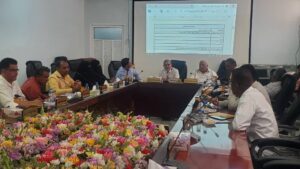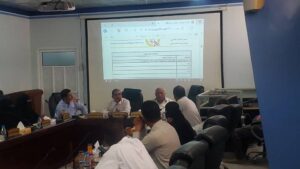In the presence of the university president, a discussion session was held to discuss the documents of the Academic Accreditation and Quality Assurance Council of Hadhramout University.
Prof. Mohamed Saeed Khanbash, President of Hadhramout University pointed out that Hadhramout University is the only university among national universities that has an internal program for academic development and quality assurance. This program is the result of research workshops held by Hadhramout University in Jeddah, Kingdom of Saudi Arabia, from March 14 to 17, 2019, in the presence of deans of colleges and experts in scientific research fields.”
This workshop was followed by other workshops and discussions, but their goal was to focus on the path of academic accreditation and quality until we reached this qualitative discussion session today.”
The discussion session was held at the University Council in the University Presidency in the presence of Prof. Salem Faraj Bamasoud, Acting Vice President for Postgraduate Studies and Scientific Research, Prof. Abdullah Eidah Baheshwan, General Director of the Academic Development and Quality Assurance Center, Deputy Deans of Colleges for Postgraduate Studies and Scientific Research, and Heads of Scientific Departments at the University’s Center for Academic Development and Quality Assurance of Higher Education to discuss nine documents.

From his part, Prof. Abdullah Eidah Baheshwan, , pointed out that the holding of this discussion session in the presence of this elite group of academic leaders from the colleges reflects the extent of the importance that we rely on in order to advance the university and its outcomes, and keep abreast with scientific and research developments; with the aim of improving the outcomes and classification of the university and its reputation among universities. He added: “The Center for Academic Development and Quality Assurance at the university will do its utmost to achieve the desired and expected results of this discussion.”
Dr. Shawqi Ahmed Al-Dais, Director of the Measurement and Evaluation Department at the Academic Development Center, spoke about the document of institutional accreditation standards and its indicators for higher education institutions in the Republic of Yemen, as well as the self-evaluation study report for higher education institutions in the Republic of Yemen. He summarized his observations on the papers of the discussion by saying:
After reviewing the main and sub-programmatic standards and their indicators, after reviewing the standards of international and Arab accreditation bodies and the draft standards of the Academic Accreditation and Quality Assurance Council, as well as the discussions and observations of all participants in the workshop; Please fill out the form by writing the name of the main standard, its branches, and its indicators according to what is suitable:
Main standard, mission and objectives, graduate characteristics and learning outcomes, There must be a mission, objectives, and graduate characteristics for each program, specific and clear learning outcomes that contribute to achieving the university’s mission, are publicly announced, and are regularly reviewed.
Sub-standard 1: Mission and objectives, Indicators: The program’s mission and objectives should guide all activities of the department such as (curricula, materials, development)
Sub-standard Graduate specifications (This standard is mentioned in the institutional accreditation document and you can refer to sub-standard number 2.3 learning outcomes and graduate specifications of academic programs. Accordingly, this sub-standard must be added.
Regarding the document of programmatic accreditation standards, he pointed out that in the indicators aspect, it should be:
- The program should define the characteristics of its graduates, in line with its mission, and in proportion to the level of academic qualification, and they should be announced.
- The characteristics of graduates should be consistent with academic and professional standards and the requirements of development and the labor market.
In the second main standard
Management of the academic program
And the second sub-standard
2.1 Program leadership
The indicators should confirm the following:
2.1.2 Program leadership supports the professional development of staff members and administrators in the program, and participation in research activities, symposiums, and scientific courses.
3.1.2 Program leadership forms various committees from staff members to carry out the operations of measurement and evaluation, curriculum development, complaints, and scientific promotions, and involves students in some of them.
In the third main standard
The curriculum
He noted that The first sub-standard1.3 Curriculum content, As well as the indicators, the curriculum plan must take into
Main Standard 3: Curriculum
Substandard 1.3: Curriculum content
Indicators: The curriculum plan should consider the sequential order of the courses vertically and horizontally across the academic years.
Main Standard 4: Evaluation and continuous improvement
Substandard 1.4: Measurement and evaluation
Observations:
- Indicator 1.1.4: Each course should have a plan to measure students’ achievement of the course learning outcomes using a variety of methods that align with the course content, in addition to a student survey and a course report.
- Indicator 2.1.4: The program should have a plan to measure students’ achievement of the program learning outcomes using a variety of methods that align with the nature of each outcome, in addition to a student and graduate survey and a report for each outcome.
- Indicator 3.1.4: A feedback system is in place to improve courses in light of the results of course evaluation.
Substandard 2.4: Continuous improvement
Dr. Shawqi Al-Dais, Director of the Measurement and Evaluation Department at the Center for Academic Development and Quality Assurance at Hadhramout University, noted that the indicators:
- Indicator 1.2.4: The program has a documented plan for improving the program based on the results of the assessment of learning outcomes and is implemented in full.
Main Standard 5: Students
Substandard 1.2.5: Academic and guidance follow-up
Indicators:
- Indicator 1.2.5: Effective academic, psychological, behavioral, and social guidance services are available to program students, according to specific plans and programs, and through specialized, qualified, and sufficient staff that are appropriate to their needs. The mechanisms for monitoring their implementation are identified.
- Indicator 2.2.5: Programs are provided to prepare new students and guide them to ensure their full understanding of the types of services and opportunities available, as well as their rights and responsibilities.
Dr. Warda Saeed Al-Mahamdi, Director of the Quality Assurance and Academic Accreditation Department at the Center, spoke about the description of academic programs and presented observations on the documents of the Aden Accreditation Council.
Her paper included observations on the documents of the Academic Accreditation Council in Aden, the most prominent of which were:
Regarding the document “Guide to Academic Accreditation and Quality Assurance for Undergraduate Programs”
- The guide did not include definitions or terms, such as who are the experts and members of the evaluation, review, and independent opinion committees and their qualifications, etc.
- Elements and levels of assessment of indicators.
- On page 14 of the table under the elements of accreditation in the paragraph on the regularity of evaluation, it is preferable to separate the phrase “no regular evaluation” and place it under the non-achieved level, since the absence of something and retaining the phrase “there is evaluation rarely under the partially achieved level.”
Regarding the document “Undergraduate Program Standards”
- Standard 7: Program facilities and equipment: It is preferable to be an institutional standard, not a programmatic one; because the facilities and equipment will be repeated for each program, as if we have reached a stage of sufficiency, and no shortcomings will appear that need improvement. An example of this is the indicator “3.1.7 The existence of various service facilities (bathrooms – restaurants – activity halls – gyms – prayer places – rest areas – private parking – maintenance workshops) and takes into account the needs of people with disabilities”.
- This indicator exists in the college that contains several programs, and all programs benefit from these facilities and equipment, but the number of programs or students in relation to the facility in the college has not been taken into account.




